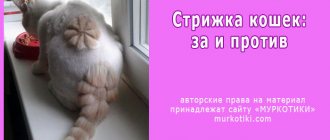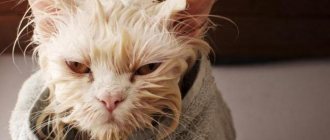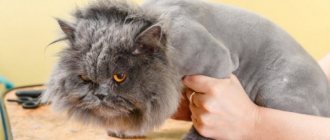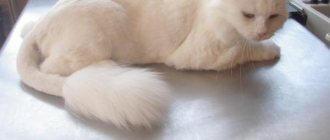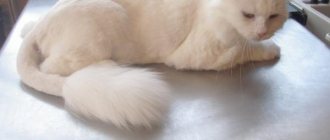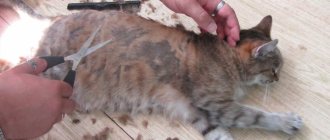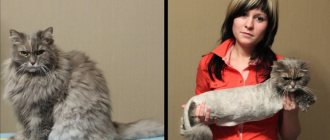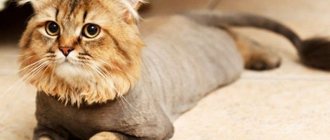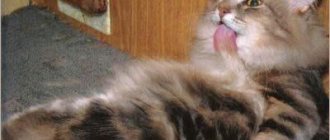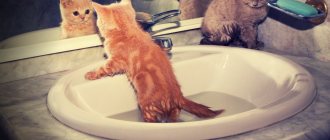The list of pet care services is very large. Owners are offered to cut, dye or style their cat's fur. Not everyone understands the need for such procedures and does not share the delight at the sight of a domestic cat cut like a lion. Usually people do not understand why owners of short-haired breeds cut their cats. For them, caring for their pet's appearance consists only of bathing. Owners of long-haired breeds can only envy them - after all, caring for long hair requires certain skills and a lot of patience.
Negative consequences and contraindications
After trimming and shaving, minor problems may arise. For example, skin damage during games. Other consequences:
- When an animal is bothered by growing hairs, it begins to itch or does it out of habit.
- The animal licks itself more often, which can lead to slight skin irritation.
- Some cats become depressed, they hide, and begin to take revenge on their owners.
- The structure of the pile changes. Its quality deteriorates, the hairs become thinner, become tangled, and new tangles form faster. This sometimes becomes a reason for disqualification, as the coat no longer meets the breed standard.
- Color may change.
- The elasticity and firmness of the skin decreases.
- When the whiskers are injured, the cat loses orientation, coordination is impaired, and moves uncertainly.
- Cuts provoke the development of inflammation.
- Sometimes hair growth stops in the shaved area. Then, after restoration of the cover, areas of baldness remain.
- Shaving a cat bald disrupts thermoregulation, which causes the development of dermatological diseases, frequent colds, sunburn, and increases the risk of skin injuries.
- An incorrectly done haircut can provoke a cat's desire to bite off its own tail.
Behavior changes less frequently and aggression appears. The cat may suddenly begin to attack, tear up furniture, or walk past the litter box. Usually this is a short-term phenomenon, otherwise the pet needs to be taken to the veterinarian. Some cats are prohibited from being groomed:
- With color-point, tipping color . Otherwise, after cutting, the color of the pile will become darker.
- Shorthair (especially Scottish Fold, British). The exception is varieties of these breeds with long pile.
- Semi-longhaired (Mae Coon, Norwegian Forest, Siberian). Pile saves animals from heat and cold.
Hyperactive cats are not groomed. Otherwise, the procedure is carried out under anesthesia, after sedatives, and it can be difficult to moderate their ardor. Do not shave the inside of the ears or paw pads. It is prohibited to administer anesthesia to animals with chronic diseases. Even healthy people can have heart failure after it.
In what cases can you not do without a haircut?
Most owners have their own opinion about the indications for grooming a cat:
- getting rid of fur on furniture and carpets during seasonal shedding;
- allergies in the owner and family members (a shorn animal has less fluff, which causes an allergic reaction);
- prevention of overheating (in the summer, cats are hot due to their thick fur coat);
- solving problems with hair (it is easier to remove fleas, ticks, burrs).
Owning a representative of a long-haired breed while suffering from allergies, helping a pet in the heat, solving the problem of seasonal shedding - experts treat such wishes with irony. These are the whims of the owners, and not a real need. Professionals allow haircuts only in two cases:
- To get rid of large tangles. Matted fur causes pain and itching, and involuntary scratching of problem areas. When there is a massive accumulation of them, the cat is cut to relieve discomfort and prevent the development of dermatological diseases.
- As part of preoperative preparation. Before surgical interventions, the animal is not only cut short, but also shaved.
A cat’s beautiful hairstyle pleases its owners, not the cat itself. An incorrectly trimmed tail can even cause your pet to try to chew it off.
Why cut a cat's hair?
The need for a haircut is determined by the owner. You can do without it, but you need to regularly take care of your body, comb it, preventing the formation of tangles. More often they affect Persian cats, whose hair structure is soft and its length reaches up to 10 cm.
Tangles that are close to the skin are very dangerous. This provokes inflammation of the integument, sometimes insects and parasites lay eggs under them. Therefore, long-haired cats need to be trimmed more often. Indications for hygienic trimming and shaving are:
- The neglected state of the cat's hair is matted, covered with tangles, and difficult to comb. This prevents the access of air, which provokes the development of inflammation and skin tightness. The animal begins to gnaw out the tangles and swallows them. Bald spots and covering injuries form on the body.
- Heat - to avoid overheating.
- When the cover gets dirty quickly, it rolls up in clumps. They cause inconvenience and cause pain when the hair is pulled.
- To make caring for a sick or old cat easier.
- The pile is stained with indelible materials (paint and varnish, polyurethane foam, adhesive solutions, fuel oil). When dirty lumps of lint enter the stomach during licking, this can cause gastrointestinal problems and poisoning.
- In long-haired animals, the hairs in the perineum and under the tail are cut to prevent excrement from sticking.
- Prolonged shedding.
- Family members have severe allergies.
Indications for medicinal purposes:
- severe damage by parasites - lice, fleas;
- preoperative preparation;
- dermatitis;
- infectious skin pathologies;
- high activity of the paraanal and sebaceous glands;
- the need to treat the skin with medications.
Decorative hairstyles and shaving are done for a photo shoot. To do this, choose fashionable haircuts. More often they are done before exhibitions and competitions.
Groomers have differing opinions about semi-longhaired cats. Their pile has a two-layer structure with an air gap. If it is disrupted, thermoregulation is disrupted. However, some veterinarians believe that these cats need to be shaved periodically to keep the coat renewed.
To cut or not to cut your pet?
During a grooming, a cat gets stressed, which can lead to unpleasant consequences. However, the determining factor is the climate in which you live and where the pet spends most of its time - outdoors or indoors. When it's very hot outside and you want to help your four-legged friend, a haircut won't be a bad idea. Despite the obvious benefits (especially for long-haired cats), clipping has some disadvantages. A trimmed animal adapts less well to temperature changes. Cats walking outside can overheat in the sun, since their skin will not be protected by fur, and the pet can catch a cold. Therefore, you should not get carried away with this procedure. It is necessary to organize proper coat care, in this way you can avoid the formation of tangles and, as a result, the occurrence of skin diseases.
How often can you cut your hair?
The frequency of cosmetic procedures depends on the age of the animal, its health, and the rate of hair regrowth. It is recommended to trim your cat 2-3 times annually. Unscheduled ones are done as needed - before exhibitions, competitions. However, an exception is sometimes made for longhaired dogs. Especially with poor hygiene. Then they trim and shave as needed or every three months.
Some cats have a hard time withstanding heat (for example, Persians). Therefore, it is recommended to cut them in spring and summer. Such rocks quickly become overgrown, so they are trimmed 2-3 times annually. Less often – cats with medium pile. For them, it is enough to trim the animal once every 12 months. In addition, a well-groomed pet is easier to treat for parasites and skin diseases.
Haircutting tools
To perform the hairstyle, you need to have special tools on hand. Scissors take sharp, medium, with rounded tips. For shaving you will need a machine - manual or powered. The second option is more preferable. It is advisable to choose a silent one so that the animal does not get scared. When shaving with manual models, the hairstyle turns out uneven.
A machine is a more effective tool than scissors. It eliminates injuries, helps to make a uniform haircut, and select an attachment based on the length of the hair. For example, 2 cm trimmers are used to shave the ears, muzzle, and area under the tail. Only powerful clippers with wide blades are suitable for animals with thick hair.
To do this, take nozzles No. 2-5. It is not recommended to use clippers with small blades - they can injure the skin. Their length should be from 0.5 mm. The recommended power of the machine when processing Angora and Persian cats is 45 W, short-haired is 20 W.
Additionally you will need:
- a massage comb and a second one with soft, sparse teeth;
- a piece of fabric;
- "Chlorhexedine" or hydrogen peroxide to treat possible skin damage;
- any flat surface (for example, a table);
- treats, toys;
- nail clipper
Since the cat must lie still during the procedure, a special collar is put on it or the desired part of the body is fixed.
How to properly cut a cat's hair
When cutting hair, it is advisable to find an assistant. He will hold the animal lying on its side, control the front legs with one hand and the hind legs with the other. It is necessary to fix the pet on the table surface quite firmly - the cat will escape out of fear, and the sound of the running machine will provoke it to escape. Try to use silent machines. It is necessary to cut cats according to a certain algorithm: start cutting from the sides, back and belly, move to the armpits, then the back. Then come the paws; if you wish, you can leave the “socks”. It is not necessary to cut the tail, but if you decide to tidy it up, leave a tassel at the end. If you decide to cut your cat's hair against the grain, use scissors and a special clipper, setting the cutting depth to 3 to 4 mm, which will prevent injury to the animal's skin. Do not forget to stretch the animal's skin in the area where the machine passes. Cutting against the grain is different in that a larger volume of hair is removed in one pass, but this method is mentally traumatic for the animal. After finishing the haircut, wipe the cat with wet wipes, or better yet, give it a bath to remove any remaining fur. Now all the fears are over, and she is ready to return to her normal life. This process is not simple, it has many nuances, and not all animals tolerate haircuts calmly. If you do not have enough skills to groom your pet on your own, it is better to contact a groomer: go to a special salon or call them to your home.
General haircut rules
Two people cut their pet's hair. The second person holds and calms. When your pet has an aggressive nature, it is recommended to perform a salon procedure, as there is a possibility that anesthesia will be required. It is also necessary for heavily overgrown dogs whose fur is covered with tangles.
When the cat is not being prepared for surgery, 2-5 mm of hair is left when shaving to maintain normal thermoregulation. When cutting hair, precautions must be taken. When using a machine, it is recommended to take a powered one. When trimming a pet, the owner must be calm, otherwise his nervousness will be transferred to the animal.
It is recommended to shave first according to the growth of the pile, then against it. Do not allow the machine to overheat. Scissors must be sharp. But for long-haired breeds they will be ineffective. You should not cut your animal's hair very short to maintain thermoregulation.
Pros and cons of grooming
The main advantages of grooming British cats are compliance with cat “fashion” and minimizing the grooming procedure. As for the minuses, there are many more of them:
- Skin without hair becomes overcooled, overheats and dries out.
- The structure of the hair changes - after cutting it becomes thin and less elastic.
- Wool and undercoat grow simultaneously, which is contrary to natural processes. When shedding, they do not fall out together; the undercoat changes more often.
- After a haircut, a temporary loss of orientation is observed, which is caused by the removal of the whiskers located on the cat’s body.
In the examples with the British breed, all of the above events can have negative consequences. These cats have a complex character and attempts to force a pet to do something against its will are met with hostility.
Haircut instructions
First, the table is treated with an antiseptic and the instruments are disinfected. Then the claws are trimmed. The cat is secured so that it lies still. When he tries to escape, they put a plastic collar on him. First, use a clipper (nozzles No. 3-5) to cut the hairs on the sides, then treat the back and stomach. They act very carefully near the nipples, in the perineum.
For the armpits, change the nozzle to No. 2. Shave the paws starting from the top, going down as far as necessary. The hair on the tail is cut so that 1/3 of the hair remains, at least a tassel. To avoid damage to the skin, it is slightly stretched.
The tangles are cut off with scissors before the hairstyle. If missed during the preparatory examination, then as soon as it is found. The coat can be cut with or against hair growth. When the procedure is completed, the cat is wiped with a damp cloth or doused with warm water and washed with shampoo. Then dry with a towel or hairdryer.
Options for common haircuts
The French Lion hairstyle is very popular . This hairstyle suits any cat, but cats with thick, long hair look especially impressive. It is ideal for the summer heat. The cat is cut like a lion, leaving only the mane, a tuft on the tail, and hair on the paws below the knees. Other types are also popular.
Fashionable haircut options
Dragon has become one of the most popular fashionable haircuts . The coat is trimmed with narrow or wide triangles, forming a mohawk. Paws and head are not cut. Dragon models are different. It’s difficult to do a fashionable haircut on your own; it’s better to take your cat to a specialist or invite a groomer to your home.
Partial haircut options
These include haircuts that are close to the natural cover or with partial shaving. For example, Continental, Harlequin, Modern . Such haircuts emphasize the extravagance of the cat.
Is it true that cats can be cut?
For cats that live in the private sector and spend a lot of time outdoors, careful care is essential. After a walk, your pet may return not only with dirty hair, but also with hair matted into lumps. In this case, scissors will come to your aid. And if your pet has long, thick hair, then to avoid such troubles it makes sense to get a beautiful haircut with the onset of the warm season. If your cat is domestic, and you have enough time, effort and patience to take care of your pet’s fur every day and keep it clean and tidy, you can avoid going to the “cat” hairdresser - groomer. Even if there is no need to cut your pet’s hair, it is advisable to use a fuminator or slicker; they comb out the dead undercoat without touching the living one.
Professional grooming
When it is not possible to trim or shave a cat on your own, or when it is being prepared for exhibitions, competitions, or photo shoots, it is recommended to contact specialized salons or professional groomers. They have experience and special tools, which eliminates damage to the vibrissae and skin trauma.
In salons, a haircut takes from 40 minutes to an hour - it depends on the complexity. To prevent the cat from being nervous about a trip or an unfamiliar place, you can call a specialist home. Anesthesia is rarely used; it disrupts the functioning of the cardiovascular and respiratory systems. The cost of a haircut varies from 700 to 1000 rubles.
Salon prices offer a full range of services - from ear cleaning to final styling. A professional groomer has a larger selection of tools - several types of combs, furminators, shaving machines, and different attachments. The photo shows how difficult it is to do haircuts. Without experience, you can even cripple an animal on your own.
If necessary, the cat is given an injection of a sedative. After the haircut, they will tell you how to properly care for it and when it is necessary to do it again. Only professionals can do a model haircut before a competition; at home, the risk of ruining it greatly increases, and you can injure the animal.
Is it possible to shave a cat's head? This cannot be done unless necessary, since wool saves the animal from the sun, heat, hypothermia, and accidental damage. It is strictly forbidden to shave your head. There are many sensitive vibrissae that cannot be injured. Cats are shaved bald when their fur is stained with substances that are difficult to wash off (cement, mortar, polyurethane foam), before surgery, or when the body is severely damaged by parasites.
How long does a cat's hair grow after shaving? This depends on various factors - the age of the animal, current diseases, nutrition. The fur usually grows back in 6 months. But in case of chronic diseases, deficiency of useful microelements, the cover takes several years to recover.
Grooming cats should be done carefully, carefully, so as not to injure the animal. The pet gets used to its new appearance in a few days. If you have any doubts about your abilities, it is better to contact a professional groomer.
Where can I groom my cat?
You can trust the specialists by visiting a special salon. Or you can do everything yourself at home. We'll talk about this in more detail below.
In the cabin
Today, many animal hairdressing salons operate successfully. They offer a wide range of services and types of pet grooming.
The main advantage is that the grooming of dogs and cats in the salon is carried out by professionals and modern specialized equipment.
Also, the salon will do grooming of any complexity, which cannot be said about an independent approach.
On your own at home
To cut a cat's hair at home, first of all, you need to acquire the necessary tools and all the necessary equipment.
Needed:
- Cutting and thinning hairdressing scissors with blunt ends;
- Machine with nozzle No. 3;
- Flat comb and brush for combing out the undercoat;
- Table for the procedure. The surface is covered with a thick blanket and then a sheet.
- Means for bathing an animal after a haircut.
But it’s not enough to just provide yourself with all the above equipment. To carry out the procedure successfully and safely, minimal grooming skills are required. Otherwise, it is recommended to entrust the matter to specialists by visiting a pet salon in your city.
